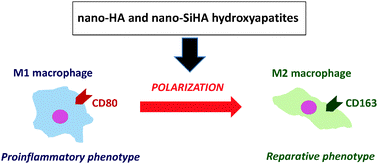Effects of nanocrystalline hydroxyapatites on macrophage polarization
Abstract
Silicon substituted and nanocrystalline hydroxyapatites have attracted the attention of many researchers due to their up-regulation in osteoblast cell metabolism and enhanced bioreactivity, respectively. On the other hand, the biomaterial success or failure depends ultimately on the immune response triggered after its implantation. Macrophages are the main components of the innate immune system with an important role in healing and tissue remodelling due to their remarkable functional plasticity, existing in a whole spectrum of functional populations with varying phenotypic features. The effects of nanocrystalline hydroxyapatite (nano-HA) and nanocrystalline silicon substituted hydroxyapatite (nano-SiHA) on the macrophage populations defined as pro-inflammatory (M1) and reparative (M2) phenotypes have been evaluated in the present study using RAW 264.7 cells and mouse peritoneal macrophages as in vitro models. M1 and M2 macrophage phenotypes were characterized by flow cytometry and confocal microscopy by the expression of CD80 and CD163, known as M1 and M2 markers, respectively. The polarization of primary macrophages towards the M1 or M2 phenotype was induced with the pro-inflammatory stimulus LPS or the anti-inflammatory stimulus IL-10, respectively, evaluating the biomaterial effects under these conditions. Our results show that both nano-HA and nano-SiHA favour the macrophage polarization towards an M2 reparative phenotype, decreasing M1 population and ensuring an appropriate response in the implantation site of these biomaterials designed for bone repair and bone tissue engineering.


 Please wait while we load your content...
Please wait while we load your content...